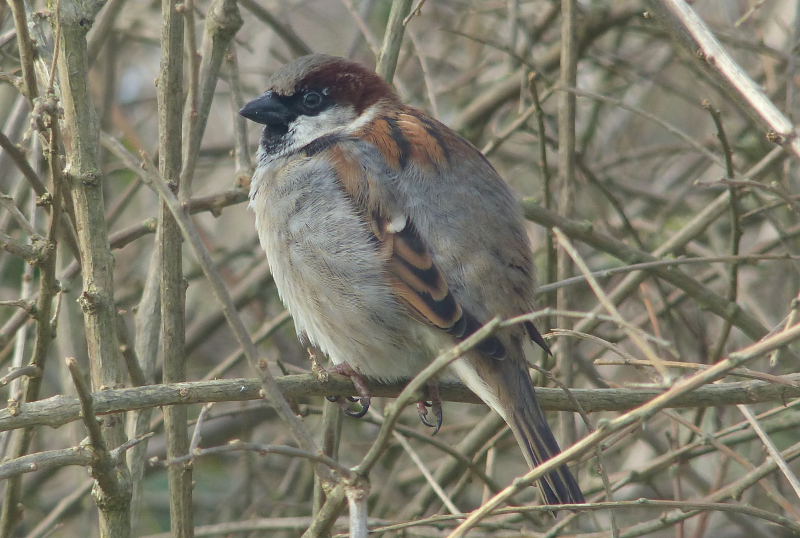Average Birding

Broadly Acceptable
With no equivalent goose chase on offer near Cromer, Sunday has a considerably more leisurely start.
Pronoun guidance: AB1 still driving. This entry covers the events of Sunday January 28th, 2018.
Sheringham
We head to Sheringham to see if we can catch up with either the Black Redstarts that have been intermittently reported there, or the apparently reliable Purple Sandpipers that frequent the front.
Sheringham is a curious place. A real mish-mash of new and old architecture. Neither of us finds the overall effect particularly convincing. The sea wall and promenades are to our liking though.
Our search for the Black Redstart is rather half-hearted. Our previous attempts at seeing one in this sort of place have been fruitless. Furthermore we've developed a more casual attitude on the back of yesterday's successes, and the effects of Friday night's sleep deprivation have started to kick in a bit. We just don't really believe it's going to happen - after a good hour of poking about, we give up.
We agree that a search for a Purple Sandpiper is more likely to yield fruit, particularly after consulting with a bunch of seawatchers who confidently direct us East along the promenade. They haven't seen the redstart either, hah.
With these instructions, we quickly find a purple friend conspiring with a group of Turnstones on a rocky promontory at the Eastern end of the promenade. We spend a fair old while marvelling at its tremendous grip on some very slippery looking rocks: It's a life tick, it needs a bit of savouring.

On the way back, I attempt a bit of seawatching. There are definitely some divers out there, but which of Red-throated, Black-throated and Great Northern they are is not discernible to my novice eyes, even through the scope.
Strumpshaw
Our next stop is Strumpshaw Fen RSPB. Well, nominally. We've been following the blog of Marcus Nash and he frequently manages to find Bean Goose in the area.
We arrive without enough time to explore the reserve and hunt for Bean Goose, and, staying in relaxed mode, opt for a very muddy walk around the reserve, picking up the first Common Snipe and Stonechat of the year.

This was really only a filler visit anyway; we're headed South and East from Cromer because, by the end of the day, we want to have made it to Stubb Mill.
Stubb Mill
We're here for one near-certainty and a couple of hopefuls. From the watchpoint (quite a pleasing walk from the car-park, punctuated only by criticism of the tour organiser's management of nutrition across the weekend), Eurasian Crane should be nailed on. Hen Harrier and Barn Owl should also be possible.
There are quite a few folks at the watch point; good - we've no idea what we're doing. Our only experience of this sort of roost watch has previously been at Wicken Fen; a much easier prospect because the area to watch is just so much smaller. At the watch point, the land around just opens up; I'd guess you can see at least 5km in every direction. It's a bit daunting; pick the wrong point at the wrong time and you could see nothing. With a group of seven or eight scopes, we'll hopefully avoid that.

We're early. Nothing happens for quite some time. This is birding, that's sometimes what happens. Further complaints are registered with the tour organiser with regard to the temperature and the amount of waiting around. Finally, a crane flaps over in front of us. All is forgiven at the appearance of this giant and its soothingly smooth flapping. Like the rest of the cranes we see over the next hour, it drops down out of sight somewhere in the far distance.
After the wait for the first one, suddenly cranes are everywhere; almost the default bird we see for the next half hour. Tremendous.
In the gaps between the cranes, I'm eyeballing all the harriers I can find. They all stubbornly remain Marsh, rather than Hen. A flock of ten cranes lands far off the left. Subsequently, one of the pros calls out "male Hen Harrier". Directions are shared out. Even with the scope the harrier is difficult to pick out; it's basically at the horizon, but as it swaps between a sky backdrop and the land, it's unmistakably the silvery grey of a male Hen Harrier. A great view it is not, but a year tick it still is.
The encroaching cold encourages us to head back to the car; no Barn Owl this time. We agree that, while the cranes were good, for a freezing your arse off in midwinter experience, we prefer Wicken.
January total: 90. We'll be done by mid March at this rate. Hah.